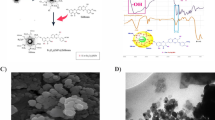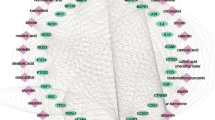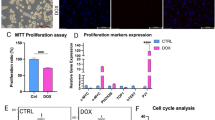Abstract
Recently, we observed that suppression of tumor xenograft growth by silibinin was associated with reduction in tumor vasculature and an increased apoptosis. Here, we provide evidence for molecular events associated with antiangiogenic efficacy of pharmacologically achievable doses of silibinin in endothelial cell culture system. Our data show that silibinin almost completely (P<0.001) inhibits growth of human umbilical vein endothelial cells (HUVEC) and human microvascular endothelial cells (HMVEC-dermal origin) together with induction of cell death in a dose- and time-dependent manner. Growth inhibition was associated with a strong induction of G1 arrest accompanied by an increase in Kip1/p27, Cip1/p21 and p53. Apoptosis induction (up to 14- to 17-fold in both cell lines, P<0.001) was an underlying mechanism in silibinin-induced death of endothelial cells. In the studies elucidating the molecular events involved in apoptosis, silibinin caused loss of mitochondrial membrane potential and an increase in cytochrome c release from mitochondria. An increase in Bax and a decrease in Mcl-1 proteins were also observed. Silibinin-induced apoptosis involved both caspase-dependent and -independent mechanisms. Silibinin also decreased survivin level and inhibited Akt and NF-κB signaling. Two different PI-3K inhibitors, wortmannin and LY294002, showed Akt-independent activation of NF-κB. Further, silibinin showed a concentration-dependent strong inhibition of capillary tube formation on matrigel, retraction and disintegration of preformed capillary network, inhibition of matrigel invasion and migration, and a decrease in matrix metalloproteinase-2 secretion by HUVEC. Together, these findings identify pleiotropic mechanisms for antiangiogenic efficacy of silibinin, and suggest its usefulness in angioprevention and antiangiogenic therapy.
This is a preview of subscription content, access via your institution
Access options
Subscribe to this journal
Receive 50 print issues and online access
$259.00 per year
only $5.18 per issue
Buy this article
- Purchase on SpringerLink
- Instant access to full article PDF
Prices may be subject to local taxes which are calculated during checkout









Similar content being viewed by others
Abbreviations
- HUVEC:
-
human umbilical vein endothelial cells
- HMVEC:
-
human microvascular endothelial cells
- VEGF:
-
vascular endothelial cell growth factor
- ΔΨm:
-
mitochondrial membrane potential
- JC-1:
-
5,5′,6,6′-tetrachloro-1,1′,3,3′-tetraethyl-benzamidazolocarbocyanin iodide
- PARP:
-
poly(ADP-ribose) polymerase
- z-VAD:
-
benzyloxycarbonyl-Val-Ala-Asp
- FMK:
-
fluoromethyl-ketone
- DEVD-pNA:
-
Asp-Glu-Val-Asp-p-nitroanilide
- NF-κB:
-
nuclear factor kappa B
- MMP-2:
-
matrix metalloproteinase-2
References
Agarwal C, Singh RP, Dhanalakshmi S, Tyagi AK, Tecklenburg M, Sclafani RA and Agarwal R . (2003). Oncogene, 22, 8271–8282.
Ali IU, Senger DR and Smith LEH . (2001). Urology, 57, 143–147.
Altieri DC . (2003). Nat. Rev. Cancer, 3, 46–54.
Baeuerle PA . (1998). Curr. Biol., 8, R19–R22.
Baeuerle PA and Baltimore D . (1996). Cell, 87, 10–13.
Baldwin AS . (1996). Annu. Rev. Immunol., 14, 649–681.
Boehm T, Folkman J, Browder T and O’Really MS . (1997). Nature, 390, 404–407.
Brakenhielm E, Cao R and Cao Y . (2001). FASEB J., 15, 1798–1800.
Brawer MK . (1996). Cancer, 78, 345–349.
Brekken RA, Li C and Kumar S . (2002). Int. J. Cancer, 100, 123–130.
Brunn GJ, Williams J, Sabers C, Wiederrecht G, Lawrence Jr JC and Abraham RT . (1996). EMBO J., 15, 5256–5267.
Carmeliet P . (2002). Nat. Med., 6, 389–395.
Carmeliet P and Jain RK . (2000). Nat. Med., 407, 249–257.
Chen JH, Hsiao G, Lee AR, Wu CC and Yen MH . (2004). Biochem. Pharmacol., 67, 1337–1345.
Cory S, Huang DC and Adams JM . (2003). Oncogene, 22, 8590–8607.
Cossarizza A, Baccarani-Contri M, Kalishnikova G and Franceschi C . (1993). Biochem. Biophys. Res. Commun., 30, 40–45.
Dhanalakshmi S, Singh RP, Agarwal C and Agarwal R . (2002). Oncogene, 21, 1759–1767.
Fotsis T, Pepper MS, Aktas E, Breit S, Rasku S, Adlercreutz H, Wahala K, Montesano R and Schweigerer L . (1997). Cancer Res., 57, 2916–2921.
Gimbrone Jr MA, Leapman S, Cotran R and Folkman J . (1972). J. Exp. Med., 136, 261–276.
Gingis-Velitski S, Zester A, Flugelman MY, Vlodavsky I and Ilan N . (2004). J. Biol. Chem., 279, 23536–23541.
Grana X and Reddy P . (1995). Oncogene, 11, 211–219.
Green GR and Reed JC . (1998). Science, 281, 1309–1312.
Gross A, McDonnell JM and Korsmeyer SJ . (1999). Genes Dev., 13, 1899–1911.
Gu Q, Wang D, Wang X, Peng R, Liu J, Jiang T, Wang J, Wang S and Deng H . (2004). Radiat. Res., 161, 692–702.
Gustin JA, Ozes ON, Akca H, Pincheira R, Mayo LD, Li Q, Guzman JR, Korgaonkar CK and Donner DB . (2004). J. Biol. Chem., 279, 1615–1620.
Hoffmann A, Levchenko A, Scott ML and Baltimore D . (2002). Science, 298, 1241–1245.
Hofseth LJ, Hussain SP and Harris CC . (2004). Trends Pharmacol. Sci., 25, 177–181.
Jiang C, Agarwal R and Lu J . (2000a). Biochem. Biophys. Res. Commun., 276, 371–378.
Jiang C, Ganther H and Lu J . (2000b). Mol. Carcinog., 29, 236–250.
Jones MK, Wang H, Peskar BM, Levin E, Itani RM, Sarfeh IJ and Tarnawski AS . (1999). Nat. Med., 5, 1418–1423.
Kaufmann S, Desnoyers S, Ottaviano Y, Davidson N and Poirier G . (1993). Cancer Res., 53, 3976–3985.
Kerbel RS . (2000). Carcinogenesis, 21, 505–515.
Kim KJ, Li B, Winer J, Armanini M, Gillett N, Phillips HS and Ferrara N . (1993). Nature, 362, 841–844.
Kitaura J, Asai K, Maeda-Yamamoto M, Kawakami Y, Kikkawa U and Kawakami T . (2000). J. Exp. Med., 192, 729–740.
Levkau B, Scatena M, Giachelli CM, Ross R and Raines EW . (1999). Nat. Cell Biol., 1, 227–233.
Li A, Dubey S, Varney ML, Dave BJ and Singh RK . (2003). J. Immunol., 170, 3369–3376.
Li P, Nijhawan D, Budihardjo I, Srinivasula SM, Ahmed M, Alnemri ES and Wang X . (1997). Cell, 91, 479–489.
Li Y and Sarkar FH . (2002). Clin. Cancer Res., 8, 2369–2377.
Madge LA and Peber JS . (2000). J. Biol. Chem., 275, 15458–15465.
Madrid LV, Wang CY, Guttridge DC, Schottelius AJ, Baldwin Jr AS and Mayo MW . (2000). Mol. Cell. Biol., 20, 1626–1638.
Malyankar UM, Scatena M, Suchland KL, Yun TJ, Clark EA and Giachelli CM . (2000). J. Biol. Chem., 275, 20959–20962.
Marchetti P, Castedo M, Susin SA, Zamzami N, Hirsch T, Macho A, Haeffner A, Hirsch F, Geuskens M and Kroemer G . (1996). J. Exp. Med., 184, 1155–1160.
Mayo MW, Denlinger CE, Broad RM, Yeung F, Reilly ET, Shi Y and Jones DR . (2003). J. Biol. Chem., 278, 18980–18989.
O’Connor DS, Schechner JS, Adida C, Mesri M, Rothermel AL, Li F, Nath AK, Pober JS and Altieri DC . (2000). Am. J. Pathol., 156, 393–398.
Okada H and Mak TW . (2004). Nat. Rev. Cancer, 4, 592–603.
Ozes OM, Mayo LD, Gustin JA, Pfeffer SR, Pfeffer LM and Donner DB . (1999). Nature, 401, 82–85.
Paggi MG, Baldi A, Bonetto F and Giordano A . (1996). J. Cell. Biochem., 62, 418–430.
Qi JH, Mastumoto T, Huang K, Olausson K, Christofferson R and Claesson-Welsh L . (1999). Angiogenesis, 3, 371–380.
Rak J, Yu JL, Klement G and Kerbel RS . (2000). J. Invest. Dermatol. Symp. Proc., 5, 24–33.
Ruoslahti E . (2002). Nat. Rev., 2, 83–90.
Saelens X, Festjens N, Walle LV, van Gurp M, van Loo G and Vandenabeele P . (2004). Oncogene, 23, 2861–2874.
Shin S, Sung BJ, Cho YS, Kim HJ, Ha NC, Hwang JI, Chung CW, Jung YK and Oh BH . (2001). Biochemistry, 40, 1117–1123.
Singh RP and Agarwal R . (2003). Curr. Cancer Drug Targets, 3, 205–217.
Singh RP and Agarwal R . (2004). Curr. Cancer Drug Targets, 4, 1–13.
Singh RP, Dhanalakshmi S, Tyagi AK, Chan DC, Agarwal C and Agarwal R . (2002). Cancer Res., 62, 3063–3069.
Singh RP, Sharma G, Dhanalakshmi S, Agarwal C and Agarwal R . (2003). Cancer Epidemiol. Biomarkers Prev., 12, 933–939.
Stiff T, O’Driscoll M, Rief N, Iwabuchi K, Lobrich M and Jeggo PA . (2004). Cancer Res., 64, 2390–2396.
Tosetti F, Ferrari N, Deflora S and Albini A . (2002). FASEB J., 16, 2–14.
Toyoshima H and Hunter T . (1994). Cell, 78, 67–74.
Tran J, Master Z, Yu JL, Rak J, Dumont DJ and Kerbel RS . (2002). Proc. Natl. Acad. Sci. USA, 99, 4349–4354.
van Moorselaar RJ and Voest EE . (2002). Mol. Cell Endocrinol., 197, 239–250.
Waddick KG and Uckun FM . (1999). Biochem. Pharmacol., 57, 9–17.
Wellington K and Jarwis B . (2001). BioDrugs, 15, 465–489.
Xiong Y, Hannon GJ, Zhang H, Casso D, Kobayashi R and Beach D . (1993). Nature, 366, 701–704.
Yamamoto Y and Gaynor RB . (2001). J. Clin. Invest., 107, 135–142.
Yoo HG, Jung SN, Hwang YS, Park JS, Kim MH, Jeong M, Ahn SJ, Ahn BW, Shin BA, Park RK and Jung YD . (2004). Int. J. Mol. Med., 13, 81–86.
Zandi E and Karin M . (1999). Mol. Cell. Biol., 19, 4547–4551.
Acknowledgements
This work was supported in part by DOD prostate cancer fellowship #PC020718 (to RPS) and USPHS Grants CA91883 and CA102514.
Author information
Authors and Affiliations
Corresponding author
Rights and permissions
About this article
Cite this article
Singh, R., Dhanalakshmi, S., Agarwal, C. et al. Silibinin strongly inhibits growth and survival of human endothelial cells via cell cycle arrest and downregulation of survivin, Akt and NF-κB: implications for angioprevention and antiangiogenic therapy. Oncogene 24, 1188–1202 (2005). https://doi.org/10.1038/sj.onc.1208276
Received:
Revised:
Accepted:
Published:
Issue date:
DOI: https://doi.org/10.1038/sj.onc.1208276
Keywords
This article is cited by
-
Fasentin diminishes endothelial cell proliferation, differentiation and invasion in a glucose metabolism-independent manner
Scientific Reports (2020)
-
Nintedanib inhibits growth of human prostate carcinoma cells by modulating both cell cycle and angiogenesis regulators
Scientific Reports (2018)
-
Cytotoxic and Antitumor Activity of Liposomal Silibinin
BioNanoScience (2018)
-
Potential therapeutic targets of Guggulsterone in cancer
Nutrition & Metabolism (2017)



